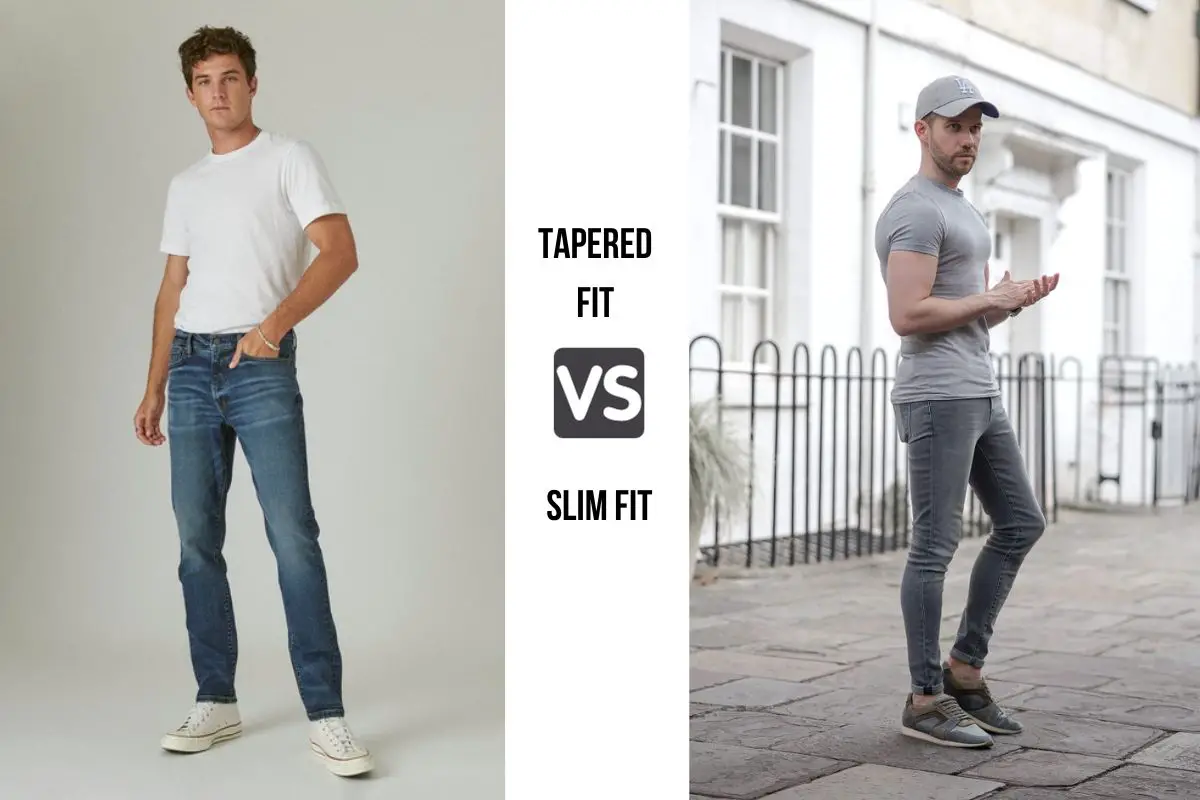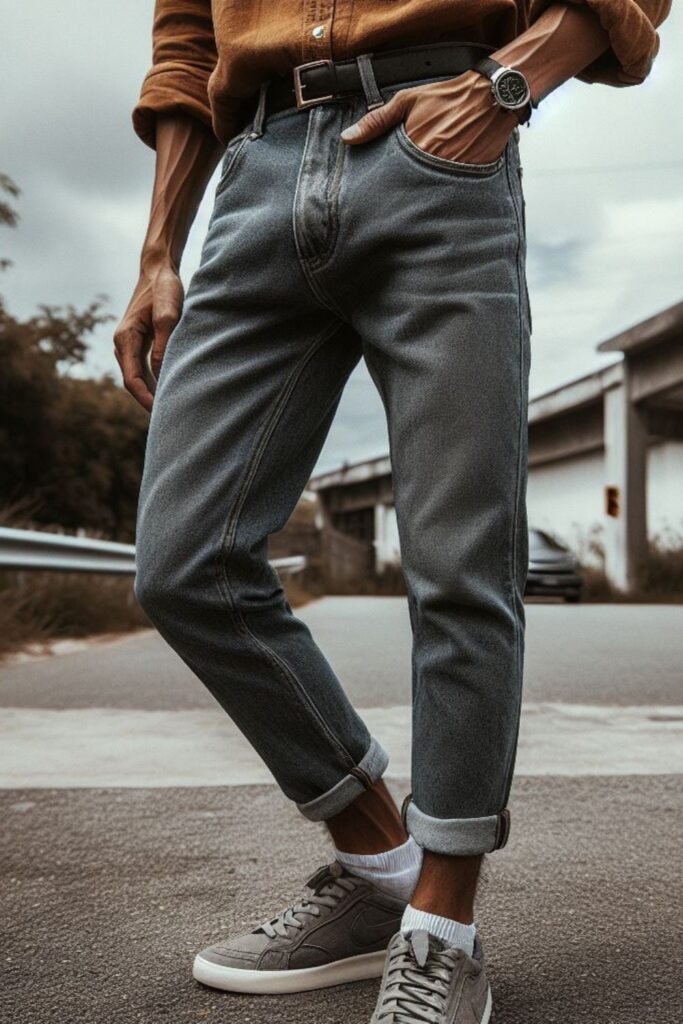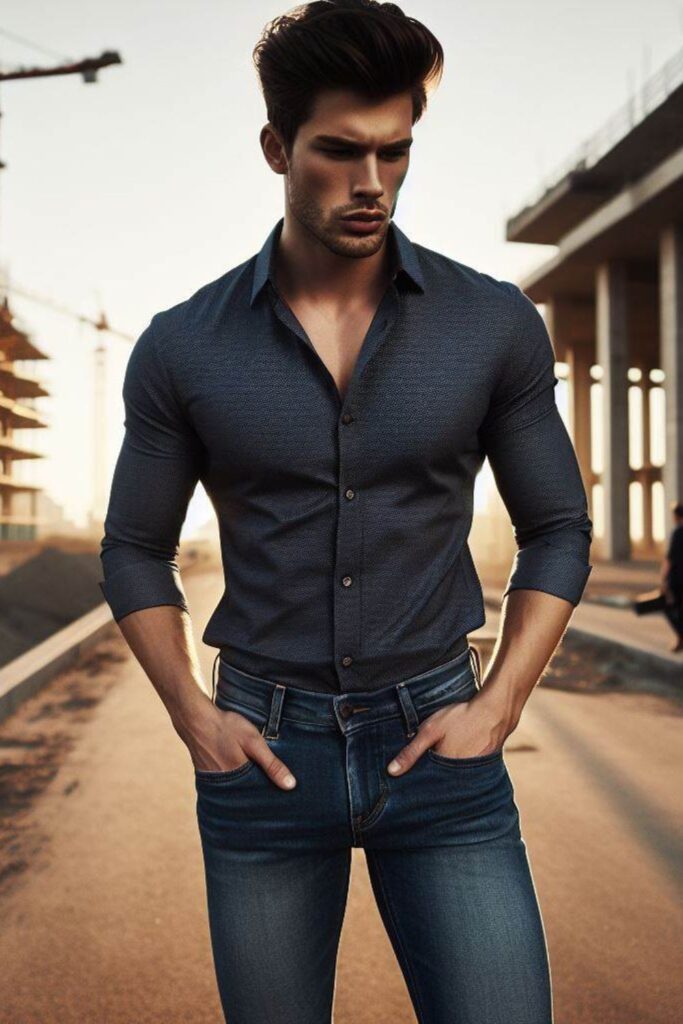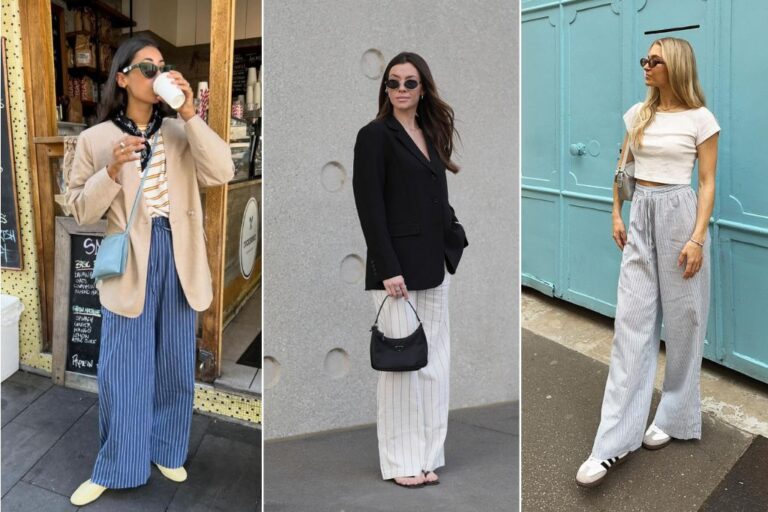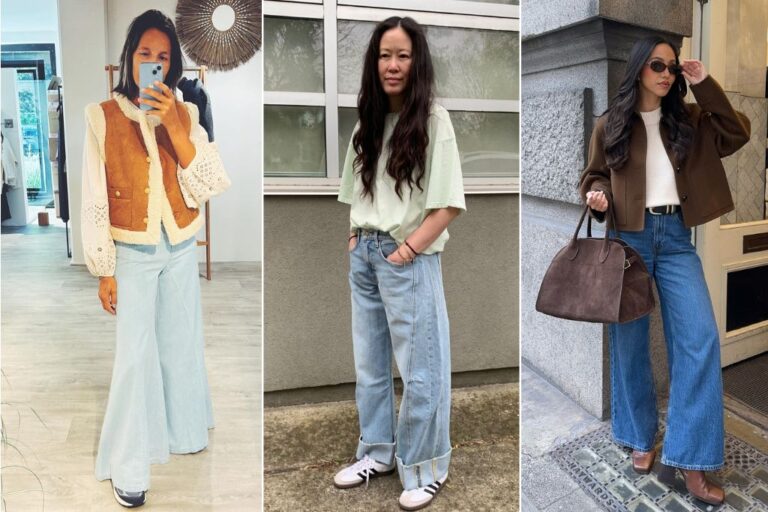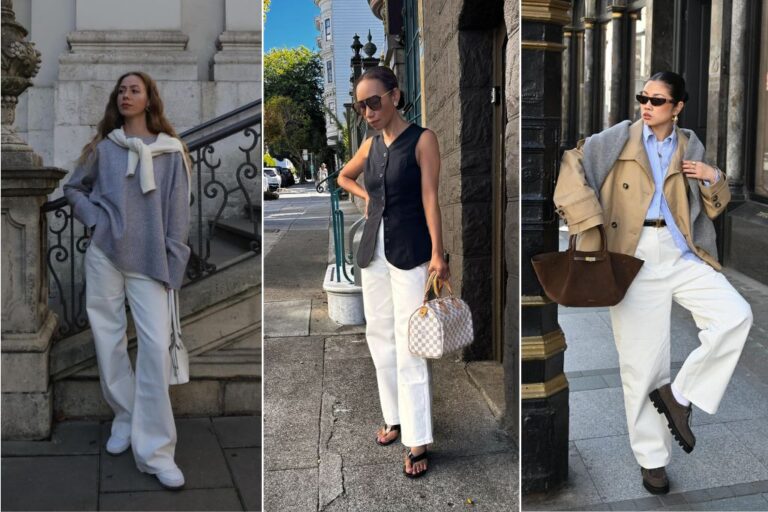Finding the perfect pair of jeans or the ideal dress shirt can seem like an impossible task. With so many fits and styles to choose from, it’s easy to feel overwhelmed. Two of the most popular options are tapered fit and slim fit clothing. But what exactly sets these styles apart?
In this in-depth guide, we will explore the key differences between tapered vs. slim fits. You’ll learn how to identify each style, what body types they are best suited for, and how to pick the right option for you.
Defining Tapered Fit
Tapered fit refers to clothing that is looser around the top half of the body but gradually narrows from the hips down towards the hemline. This creates an inverted triangle silhouette.
The Origin of Tapered Fits
While slim and skinny fits rose to popularity in the 1980s and 90s, tapered clothing has a more recent origin story.
Historically, women’s pants were quite loose and flowing. It wasn’t until the 1950s that narrow tapered “cigarette pants” emerged as a trend. For men, tailored breeches were common in centuries past. But it took until the late 20th century for tapered pants to hit the mainstream.
Nowadays, you can find tapered fits on all types of bottoms, from jeans to trousers and joggers. The style is also applied to shirts, creating a looser shoulder with a nipped in waist.
How Do Tapered Pants Fit?
Tapered pants have a straight or wide fit through the hips and thighs. The tapering effect starts somewhere below the knees, gradually narrowing down towards the ankle opening.
Some tapers are quite drastic, creating a narrow bottom. Other pants have just a slight taper for a more subtle look. The amount of taper can range from 1 to 3 inches smaller at the ankle compared to the thigh.
On shirts, a tapered fit has wide, relaxed shoulders and chest, with fabric removed at the waist. This creates the signature “V” shape.
Who Can Wear Tapered Fits?
Tapered clothing flatters a wide variety of body types. The roomy top balances curvy hips and athletic thighs. The narrowed ankles create a streamlined silhouette.
Men with stocky builds or larger waist sizes often prefer the generous top half of tapered pants. The style also suits taller men, minimizing the discrepancy between torso and legs.
For women, tapered pants flatter pear shapes. The loose top half balances out wider hips. Just be sure to choose the right amount of taper for your body. An extreme taper can accentuate bottom-heavy figures.
Tapered Shirts
Tapered shirts work well for men with broad chests or muscular arms. The looser shoulder and sleeves accommodate larger upper bodies. The tapered waist flatters and slims thicker middles.
For women, tapered blouses balance broad shoulders while defining the waist. Bustier figures can size up for room through the chest, then benefit from the shaping below.
Just avoid extreme tapers that cause gapping buttons or a squeezed chest. Moderate tapers sculpt without constricting.
What is Slim Fit?
Slim fit clothing has a close, body-skimming silhouette from top to bottom. Rather than tapering in or out, slim fits maintain the same sleek shape throughout.
A Brief History of Slim Fits
While tapered clothing is relatively new on the scene, slim fits have long been a staple. Slim suits were fashionable in the 60s. Slim jeans rose to fame in the 80s and continue popular today.
The key difference is that modern slim fits have more stretch for comfort. Materials like spandex and lyocell allow for a sculpting look that moves with the body.
How Slim Fit Pants Are Cut
Slim fit pants are cut close through the hips and thighs, down to the ankle. They contour the body without restrictive clinging.
To achieve a slim leg, pants have a narrowed leg opening. Slim fit jeans will have a leg opening of around 14 – 15 inches. Regular fits are closer to 16 – 18 inches.
Some brands offer “slim straight” fits. These maintain a slim profile with a subtle taper at the ankle.
Slim fit trousers and chinos follow the same guidelines – narrowly cut through the hips and thighs with minimal stacking at the shoe.
Who Can Wear Slim Fits?
Slim fits work best for slender, straight body types. They follow the natural lines of the body without adding bulk.
For curvier figures, sizing up in slim fits can help provide needed room through the hips and thighs. But beware – going too oversized ruins the intended silhouette.
Slim fit pants also suit men with skinny legs, showing off their natural shape. However, athletic guys with bigger quads or calves should opt for a more generous fit through the thighs.
How Slim Fit Shirts Are Designed
Slim fit shirts contour the chest, shoulders, and waist without constricting. They are trim through the body but not uncomfortably tight.
For best results, pay attention to shoulder and sleeve measurements. Slim sleeves require less bicep circumference. Make sure sleeves don’t strain at the bicep or gap at the shoulder.
Slim fit shirts work well for both athletic and slim body types. The fitted design provides definition without loose fabric. Just be cautious of sizing down too much, as slim shirts have less give than relaxed options.
Key Differences Between Tapered and Slim
While both tapered and slim offer a more tailored look than relaxed fits, they achieve distinct silhouettes. Here are the main ways to distinguish the two:
- Tapered fits are roomy through the hips and thighs, narrowing from mid-leg down. Slim fits maintain the same close cut from waist to ankle.
- Tapered pants and shirts create an inverted triangle shape – wide at the top, narrow at the bottom. Slim fits highlight the natural lines of the body.
- Tapered fits accommodate larger thigh and hip measurements. Slim fits work for straighter figures.
- Tapered shirts have a loose chest and shoulders with a nipped waist. Slim shirts contour the upper body.
- Tapered fits balance top and bottom halves. Slim fits show off lean legs.
The amount of tapering and slimness can vary between brands. In general, tapered fits offer more room through the upper half while slim fits are clean-cut throughout.
Slim vs. Classic Fits
Beyond tapered and slim, another option is the classic or regular fit. Comparing slim vs classic fits reveals more key differences.
Classic fits have an easy, relaxed shape with minimal shaping. They offer complete ease of movement and comfort.
Some main distinctions between classic and slim fits include:
- Classic fits have straight side seams and a boxier shape. Slim fits use curved seams and darts to contour the body.
- Classic fits provide room through the chest, shoulders, and thigh. Slim fits are cut close to the frame.
- Classic fits are designed for comfort and versatility. Slim fits create a sleek, sharp silhouette.
- Classic fits accommodate larger body types and sizes. Slim fits work for narrower figures.
- Classic fits have a casual, laidback vibe. Slim fits are more polished and put-together.
So in summary, classic fits offer relaxation while slim fits provide definition. Choose classic for comfort and slim for shaping.
Slim vs. Skinny Fits
Another point of confusion is slim versus skinny fits. Though they sound synonymous, slim and skinny fits have distinct differences.
Skinny fits are cut extremely close to the body, often with heavy stretch fabrics. This allows them to cling tightly from waist to ankle.
Comparatively, slim fits skim the frame but don’t bind or constrain. They offer a sleek shape with enough room to move comfortably.
Here’s an overview of how slim and skinny fits vary:
- Slim fits contour the natural curves of the body. Skinny fits cling and compress.
- Slim fits have some ease of movement. Skinny fits restrict mobility.
- Slim fits work for most body types. Skinny fits only suit very slender figures.
- Slim fits use less spandex and stretch. Skinny fits contain Lycra and elastic.
- Slim fits have refined polish. Skinny fits have an edgy, scene vibe.
Overall, slim fits flatter the body’s shape while skinny fits cling to create an ultra-lean look. Make sure to choose slim fits that feel comfortable rather than constricting.
Which Body Types Suit Each Fit?
To find the most flattering option, consider your individual figure. Certain body types align better with tapered, slim, or classic fits.
Body Types for Tapered Fits
Tapered fits flatter these body types:
- Triangular figures with broad shoulders and narrow hips
- Pear shapes with slimmer tops and wider hips/thighs
- Athletic physiques with defined upper bodies
- Stocky builds with boxier torsos
- Plus size bodies that need room through hips and thighs
The tapered shape balances wider hips and accommodates thicker legs. Just don’t choose an extreme taper if you are bottom-heavy.
Body Types for Slim Fits
Slim fits work best for:
- Ruler figures with straighter hips and waist
- Inverted triangle shapes with wider hips and narrow shoulders
- Lean and slender frames lacking curves
- Teen or petite bodies without defined waist
- Athletic physiques with narrow hips and legs
Slim fits follow the natural lines of straight, thin physiques. They can also sculpt curves for hourglass figures.
Body Types for Classic Fits
These bodies tend to suit classic fits best:
- Plus size or curvy figures needing room in hips and thighs
- Stocky and muscular builds requiring space for mass
- Athletic bodies with defined quads and calves
- Rounder figures lacking definition at the waist
- Inverted triangle shapes needing room across shoulders
Due to their generous cut, classic fits allow freedom of movement for bigger body types. They minimize tightness or pulling across the frame.
Finding Your Perfect Fit Shirt
Shirts come in an even wider range of fits from baggy to body-tight. Use these tips to find your ideal shirt silhouette.
Tapered Shirts
Tapered shirts have a roomy chest and shoulders with a narrower waist. Look for:
- 2-3 inches less at the waist than the chest measurement
- Full mobility without shoulder or arm constriction
- A comfortably tapered V shape, not overly nipped
Avoid extreme tapers on larger bellies. Moderate tapers balance broad chests and athletic shoulders.
Slim Fit Shirts
Slim fit shirts contour the chest, arms, and waist. Seek out:
- A chest/shoulder fit close to your measurements
- Slim sleeves with room to move – not skin-tight
- A straight waist without pulling or gapping at buttons
Slim shirts work well for tucking into pants. Just ensure you have mobility and breathe easily.
Classic Fit Shirts
Classic fit shirts offer ease through the body with minimal shaping. Seek out:
- 2-3 inches more than your chest measurement
- Full upper arm movement – not too slim in the sleeves
- A straight hem that falls below your waistband
Avoid classic fits if you are short or petite – the boxy shape will overwhelm your frame.
Expert Tips for Finding the Perfect Fit
Follow these pro tips to evaluate fits and determine the most flattering match:
- Focus on fit at the shoulders and waist – two spots that make or break a garment’s silhouette.
- Try on multiple sizes, even going up or down from your usual. Sizing fluctuates widely across retailers.
- Sit, walk, and raise your arms. Make sure you have full mobility without pulling or restriction.
- Determine if seams fall correctly without gaping, pulling, or distorting.
- Strike a balance between shaping and comfort based on your preferences.
- Judge tapered pants by their thigh width and the amount of ankle taper.
- Slim pants should contour thighs without clinging or squeezing.
- For classic fits, ensure looseness isn’t overwhelming your frame.
- Get a second opinion! Have a trusted friend or salesperson evaluate the fit.
Finding clothes with an exceptional fit feels like discovering treasure. By understanding your body type and preferences for shaping vs. ease, you can determine whether tapered, slim, or classic fits are your perfect match. With some trial and error, you’ll be able to identify winning silhouettes in an instant.
Frequently Asked Questions
Q: Are slim and skinny jeans the same?
A: No, slim and skinny jeans differ significantly. Skinny jeans cling very close to the body and limit mobility. Slim jeans simply contour the legs without constricting.
Q: Can plus-size bodies wear slim fit?
A: Yes, plus-size figures can often wear slim fits successfully by sizing up. Opt for styles with added stretch and avoid anything too restrictive.
Q: Are slim-fit pants okay for professional settings?
A: Slim dress pants offer a refined, tailored look. Just choose slacks with a subtle slim shape, not an overly skinny leg.
Q: What fit is most versatile for men?
A: Most men find classic or straight fits the easiest to dress up or down. But athletic and slim guys can successfully wear slim fits for versatility too.
Q: Will tapered pants overwhelm a petite frame?
A: To avoid looking swallowed up, petite ladies should choose very subtle tapers of no more than an inch. Avoid dramatic slimming towards the ankle.
Conclusion: Finding Your Perfect Fit
Whether you prefer the sculpted look of slim fits or the effortless comfort of classic fits, identifying the best match for your body is essential. Seek out tapered fits to balance curvier frames or slim fits to showcase slender shapes.
The most flattering clothing follows the natural lines of your figure. With so many fit options to evaluate, don’t be afraid to experiment. The right pair of jeans or perfect dress shirt is out there waiting – go find it!
We would love to hear your experiences finding fitted clothing. Share your favorite fits and brands in the comments below!
